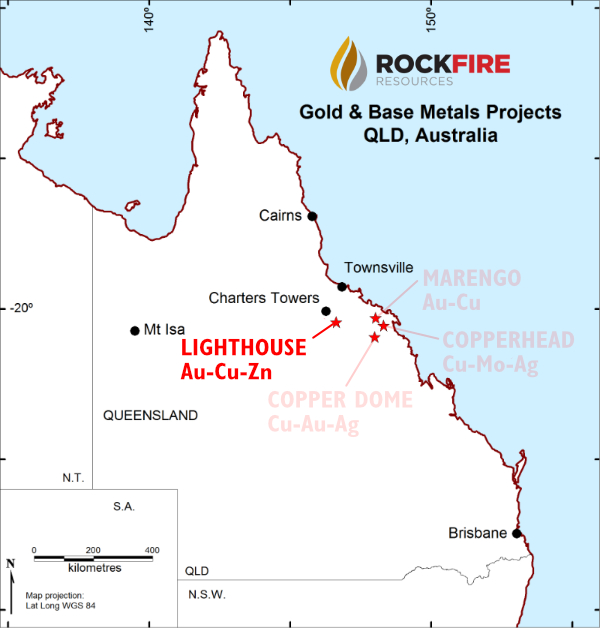
Lighthouse/Plateau (Au/Ag)
Inferred JORC Resource 3.9 Million tonnes @ 1.1 g/t Au and 6.4 g/t Ag for 131,302 Oz. gold and 800,000 Oz. silver (using a 0.5 g/t Au cutoff)
On 5th January 2023, Rockfire entered into a Binding Agreement with ASX-listed Sunshine Gold Limited (ASX:SHN) for Sunshine to farm-in to the project and earn up to a 75% interest in the tenement. On Sunshine achieving 75% ownership, Rockfire shall have the right to elect to contribute 25% of on-going expenditure, or to convert to a 1.5% Net Smelter Royalty (NSR).
The Lighthouse tenement (EPM 25617) is located approximately 50km southeast from the gold mining centre of Charters Towers in Queensland Australia. Charters Towers has produced more than 6 million ounces of gold.
The tenement comprises multiple prospects including Plateau, Bell Rock, Split Rock, Jeddah and Double Event. Numerous styles of gold mineralisation are known within the tenement including breccia-hosted, epithermal, structurally-controlled and porphyry targets.
Lighthouse straddles two of the most productive structural corridors on the east coast of Australia, hosting Pajingo (2.7 Moz. gold), Mt Leyshon (4 Moz. gold, 2.3 Moz. silver), Ravenswood (4 Moz. gold) and Charters Towers (+6 Moz. gold). Rockfire is targeting similar, multi-million-ounce deposits.
The tenement has been explored previously by large, multinational corporations including Esso, Battle Mountain, Aberfoyle, Newcrest, CRA and Penarroya. More than 4,500 m have been drilled historically within the Lighthouse tenement.
The most advanced prospect is the Plateau Gold Prospect. Plateau hosts gossanous and jasperlitic veins and gold-bearing breccia at the margin of a felsic (rhyolite) plug. Drilling at Plateau has intersected 177 m @ 0.50 g/t Au and 90 m @ 0.80 g/t Au, amongst other promising, long intervals. Recent exploration in 2020 by Rockfire has intersected 22m @ 2.0 g/t Au, 341 m @ 0.2 g/t Au, 142 m @ 0.3 g/t Au and 170 m @ 0.4 g/t Au.
Excellent drilling results have also been encountered at the Double Event Prospect, where high gold values including 3m @ 5.20g/t Au and 2m @ 13.20g/t Au have been intersected in previous drilling. During two drilling campaigns by Rockfire in 2018, drilling encountered 3m @ 10.04g/t Au and 2m @ 4.0g/t Au.
This drilling has confirmed that high grades are achievable at each prospect and these intersections demonstrate the potential of the Lighthouse Project to host significant, near-surface gold deposits. 53,000 ounces of gold have been identified within the top 100 m from surface at Plateau.
Rockfire aims to further explore the Plateau Prospect, as well as following up numerous prospects elsewhere within the tenement. Additional drilling at Plateau could see this project become a large-scale gold deposit.
Prospect Appraisals
PLATEAU
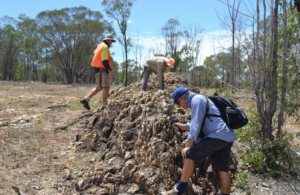 Penarroya collected 193 soil samples and 120 stream samples in 1979 around the immediate area of Plateau. At the conclusion of the 1979 field season, Penarroya geologists concluded that “…assuming that ore grades of Cu, Pb, Zn exist within the fault zone, a speculative two million tonne deposit could exist.” Eeson B et al., (1980).
Penarroya collected 193 soil samples and 120 stream samples in 1979 around the immediate area of Plateau. At the conclusion of the 1979 field season, Penarroya geologists concluded that “…assuming that ore grades of Cu, Pb, Zn exist within the fault zone, a speculative two million tonne deposit could exist.” Eeson B et al., (1980).
In 1980, Penarroya undertook the first round of drilling at Plateau. Four (4) RC holes for 591m were drilled. Hole 1 was abandoned due to caving, Hole 2 intersected 166m of pyrite, Hole 3 intersected 54m of pyrite and Hole 4 intersected a 9m wide zone of pyrite. No gold was analysed.
Esso Australia Ltd acquired the licence in 1983 and undertook extensive work including 876m of core drilling (3 holes), 350m percussion drilling (4 holes) and 126m of pre-collar drilling for a total of 1,352m. This is the first exploration campaign which analysed for gold and impressive drilling results for gold were encountered including: 3m @ 4.87g/t Au, 3m @ 3.38g/t Au, 89m @ 1.57g/t Au, 5m @ 2.77g/t Au, and 40m @ 1.37g/t Au.
During 1987, City Resources Ltd undertook further exploration including ground magnetics, IP and Mise-a-la-Masse. In early 1988, City drilled 30 RC drill holes for 1,670m at Plateau. Values up to 16g/t Au were intersected in drilling which tested gold mineralisation down to 60m vertical depth. Best results from this drilling include: 8m @ 3.03g/t Au, 10m @ 5.01g/t Au, 14m @ 2.44g/t Au, 6m @ 3.20g/t Au, and 4m @ 4.79g/t Au.
CRA Exploration Pty Ltd farmed into the exploration licence with City and undertook regional and semi-regional geophysics, geological mapping, stream sediment BLEG sampling, rock sampling, ground magnetics and radiometrics. From 1992 through to 2008, exploration field work by various companies including Aberfoyle, Liontown, Plutonic and Newcrest focussed on other regional prospects and very little work was undertaken within the Lighthouse tenement itself.
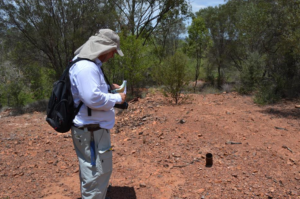 Newcrest undertook drilling at Plateau in 2007 when it drilled a single 853.7 m deep drill hole (PLDD06001). This hole was designed to test the rhyolite plug and mineralization at depth beneath the southern edge of the rhyolite. This hole was an outstanding success and intersected the projected mineralised lode at the edge of the felsic plug more than 500m vertically below the drilling closer to the surface. The drill hole intersected 2m @ 1.0g/t Au and +30g/t Ag, confirming that the structure and associated gold and silver mineralisation continues to at least 500m vertical below surface. This offers the possibility for a large, mineralised system extending to this depth and beyond. An assay of 1m @ 102g/t Ag was also intersected mid-way through the hole at 411m deep. Seven spatially separate one-metre intersections occur throughout the hole which assay above 20g/t Ag.
Newcrest undertook drilling at Plateau in 2007 when it drilled a single 853.7 m deep drill hole (PLDD06001). This hole was designed to test the rhyolite plug and mineralization at depth beneath the southern edge of the rhyolite. This hole was an outstanding success and intersected the projected mineralised lode at the edge of the felsic plug more than 500m vertically below the drilling closer to the surface. The drill hole intersected 2m @ 1.0g/t Au and +30g/t Ag, confirming that the structure and associated gold and silver mineralisation continues to at least 500m vertical below surface. This offers the possibility for a large, mineralised system extending to this depth and beyond. An assay of 1m @ 102g/t Ag was also intersected mid-way through the hole at 411m deep. Seven spatially separate one-metre intersections occur throughout the hole which assay above 20g/t Ag.
In 2017, Rockfire drilled 11 holes for 2,111m of RC drilling at Plateau. This drill campaign successfully encountered 22m @ 1.86g/t Au + 22g/t Ag (including 12m @ 2.45g/t Au), 10m @ 1.37g/t Au + 12.4g/t Ag (including 2m @ 4.43g/t Au), 18m @ 1.0g/t Au + 10.5g/t Ag, 10m @ 1.9g/t Au and 9g/t Ag (including 4m @ 3.65g/t Au) and 20m @ 0.50g/t Au (including 9m @ 0.9g/t Au).
In addition to this, significant base metal and associated mineralisation was encountered in this drilling including 16m @ 1.1% Zn, 40m @ 3g/t Ag, 43m @ 4g/t Ag, 24m @ 0.5% Zn, 43m @ 2g/t Ag and 20m @ 0.2% Cu from surface.
With consistently wide intervals of multi-element mineralisation being encountered at Plateau, the Company’s technical team is observing similarities to the operating Mt Wright Gold Mine (+1.5Moz gold), located 50km northeast of Plateau and believes another breccia complex similar to Mt Wright may exist at Plateau. Zinc/Lead/Silver ratios at Plateau are similar to the upper levels of Mt Wright (surface down to 160m deep), indicating that the best developed gold mineralisation may potentially be deeper than the current level of drilling.
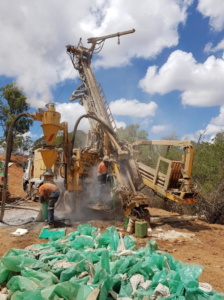 Aberfoyle Exploration summarised the potential for Plateau to host a high-grade gold deposit and provided compelling evidence that Plateau has similarities to Kidston and Mt Leyshon gold deposits;
Aberfoyle Exploration summarised the potential for Plateau to host a high-grade gold deposit and provided compelling evidence that Plateau has similarities to Kidston and Mt Leyshon gold deposits;
• Identical Permo-Carboniferous felsic (rhyolitic) intrusives
• Similar lead isotopes, base metal association and alteration to Mt Leyshon and Mt Wright
• Geometry of the plug is unknown but surrounded by hydrothermal breccia and veining
• Surrounding areas covered by laterite have only received wide-spaced drilling
• Plateau has a geophysical signature of high Potassium (K) and magnetic low like Mt Leyshon
• Plateau has returned potential “ore grade” intercepts from a district that has produced +10M ounces gold
Drilling at Plateau has not been systematic. Sixty-two (62) RC drill holes, four (4) diamond tails, and four (4) full diamond drill holes have been drilled over a strike length of approximately 800m. Plateau is open at depth, along strike and hosts multiple, un-drill tested, sub-parallel, fault zones which warrant drilling.
Click here to view the Plateau photo gallery
DOUBLE EVENT
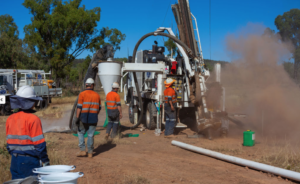 Early records show historical production from Double Event of 1,889 tons returning 1,744 ounces of gold (average grade of 28.71g/t Au).
Early records show historical production from Double Event of 1,889 tons returning 1,744 ounces of gold (average grade of 28.71g/t Au).
Western Mining Corporation Limited undertook preliminary rock chip sampling (involving 179 samples) at the Double Event Prospect, with an additional 48 dump samples collected. Rock samples returned high-grade gold including: 87g/t, 65g/t, 61g/t, 60g/t, 58.5g/t, 58g/t, and 55.5g/t Au. The average rock sample grade was 8.00 g/t Au. Similarly, the dump samples were strongly anomalous with results including 8.10g/t Au and 5.18g/t Au.
Rock sampling has also discovered a secondary mineralised fault system which occurs approximately 100m north of the main lode which is also characterised by high-grade gold values up to 20.26g/t Au. This provides opportunity for multiple, sub-parallel mineralised lodes to be identified at Double Event. No significant soil sampling has been undertaken at Double Event.
Battle Mountain Ltd acquired the Lighthouse licence area in 1987 and drilled 25 RC holes for 798m.
Quartz veining has been mapped over a strike length of more than 3km in an east-west direction. A section of the quartz lode (approximately 400m long) on the eastern end of the mapped quartz outcrop was initially drilled with 5 RC holes (numbers LTR8-11 & 13). This drilling intersected 2m @ 13.2g/t Au, 2m @ 4.1g/t Au, 1m @ 3.3g/t Au, 2m @ 2,7g/t Au and 1m @ 3.9g/t Au.
Subsequent exploration by Rockfire in 2018 infilled and enhanced this 400m section of lode when drilling intersected 3m @ 2.1g/t Au, 2m @ 4.0g/t Au, 1m @ 4.8g/t Au and 1m @ 6.0g/t Au. All of these intersections lie within 25m from the surface.
Battle Mountain Ltd also drilled a second section of the strike, but this time in the western part of the mapped outcropping quartz vein, some 2.5km to the west of the eastern lode. The section tested was similarly 400m in length and RC drilling returned very poor results including 2m @ 0.36g/t Au, 6m @ 0.1g/t Au, 1m @ 0.6g/t Au and a single stand-out intersection of 2m @ 4.65g/t Au.
 Geological and structural mapping by Rockfire in 2018, along with high-resolution photogrammetry and ground magnetics led the Rockfire geologists to believe the holes drilled by Battle Mountain had been drilled too far to the south and had missed the gold mineralisation. After repositioning the drilling rig further to the north, subsequent drilling by Rockfire intersected 3m @ 10.04g/t Au, 1m @ 5.09g/t Au, 2m @ 3.17g/t Au and 3m @ 2.94g/t Au. These results proved that careful geological observations and tenacity by our geologists are essential in finding gold deposits.
Geological and structural mapping by Rockfire in 2018, along with high-resolution photogrammetry and ground magnetics led the Rockfire geologists to believe the holes drilled by Battle Mountain had been drilled too far to the south and had missed the gold mineralisation. After repositioning the drilling rig further to the north, subsequent drilling by Rockfire intersected 3m @ 10.04g/t Au, 1m @ 5.09g/t Au, 2m @ 3.17g/t Au and 3m @ 2.94g/t Au. These results proved that careful geological observations and tenacity by our geologists are essential in finding gold deposits.
Click here to see the Double Event photo gallery
LOWER LIGHTHOUSE
Pan Australian Mining Limited commenced exploration at the Lower Lighthouse Prospect in 1990. Twenty-four (24) rock chip samples were taken in and around the old workings at Lower Lighthouse with very high-grade gold being returned including 11.40/t, 12.80g/t, 15.80g/t, 23.00g/t, 36.00g/t, 33.00g/t and 13.60g/t Au.
Following such high results, Pan Australian drilled 11 RC drill holes for a total 405m. This drilling intersected significant results from 5 of the 11 holes, including 2m @ 0.77g/t Au, 4m @ 1.46g/t Au, 6m @ 0.37g/t Au and 2m @ 0.78g/t Au. Importantly, some of the holes do not appear to have been drilled close enough to the outcrop to intersect the main lode and may have been drilled too far away from the mineralisation.
In 1992, Mt Leyshon Gold Mines Limited drilled 6 RC holes for 258m at Lower Lighthouse, with results including 2m @ 6.25g/t Au (from 12m deep), 2m @ 1.5g/t Au (from 8m deep) and 2m @ 1.92g/t Au (from 12m deep).
SPLIT ROCK
In 1992, Aberfoyle Resources Limited undertook reconnaissance sampling, ground magnetics, geological mapping, and stream BLEG sampling around the Split Rock Prospect (previously called Horse Creek). Rock chip sampling returned high-grade copper results including 11.3% Cu, 5.0% Cu and 4.6% Cu. Along with copper, rock samples also returned anomalous gold (3.47g/t Au and 3.65g/t Au) and anomalous silver (38.1g/t Ag). These results occur over a strike length of over 800m, making Split Rock a high-priority target.
Ramelius Resources drilled two RC holes at Split Rock, with RC chips (which are available in the Rockfire core yard in Charters Towers) showing extreme alteration. Alteration grades downhole from epidote-rich, through iron/magnetite and finally into silica alteration towards the bottom of each hole. The entire alteration package is approximately 60m thick and each hole terminates in strong alteration. The two RC holes hit only low-level gold and copper mineralization.
BULLSEYE
The Bullseye Prospect was first sampled in 1985 by Esso Australia and eight (8) reconnaissance rock chip samples were taken. Results include 0.15ppm Au, 0.1% Cu, 0.1% Pb, 0.1% Zn, and 15ppm Ag.
Dalrymple Resources NL undertook shallow drilling at the Bullseye Prospect in 1991 with very encouraging results for zinc mineralisation. hole BLP002 was anomalous in zinc above 1000ppm for its entire length of 108m, with a higher-grade zone of 6m @ 0.88% Zn only 50m from surface.
CARDIGAN DAM
Historical rock chip sampling has been sporadic at Cardigan Dam. Gold-in-rock results at the central main zone returned high-grade intercepts including 11.4g/t Au, 5.6g/t Au and 5.4g/t Au).
Soil sampling shows potential for a strongly mineralised gold (+/- copper) bearing system. There is a main central zone which is orientated east-west, along with a north-eastern zone which is not fully defined. The strong gold and copper anomalism make Cardigan Dam a highly prospective exploration target.
BLUFF CREEK
Rock sampling undertaken by previous explorers returned high-grade gold and silver results (47.0g/t Au and 16.0g/t Ag). The mineralisation is centralised in multiple, sub-parallel fault zones which have a west-northwest strike. Rock sampling covers an area approximately 300m by 200m but is sparsely sampled. Additional rock sampling is recommended. No soil sampling exists at Bluff Creek.
Ten (10) historic RC drill holes were drilled by Mt Leyshon Gold Mines in 1992. Best results include 2m @ 7.3g/t Au and 2m @ 6.8 g/t Au. Future exploration planned by Rockfire includes geological mapping, systematic rock sampling and additional drilling.
